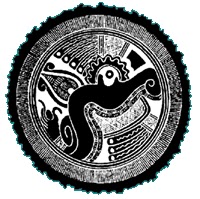The
birds of Nicaragua are diverse and, in many natural areas, abundant. Many of them are only found in forests, never in gardens or towns. Woodcreepers (Family Dendrocolaptidae) are examples of birds which do not prosper in areas with much human impact. Several woodcreeper species can be found in
Laguna de Apoyo Nature Reserve, but only in areas where human influence is limited.
.jpg) |
| Ivory-billed Woodcreeper (Lepidocolaptes flavigaster) in Laguna de Apoyo Nature Reserve, Nicaragua. Photo by Pier-Oliver Beaudrault. |
The woodcreepers crawl along the trunks of trees similarly to woodpeckers. All of them have a rufous-brown base color, some are quite similar. They use their tails for leverage against the tree trunks, and seek invertebrates on and within the bark.
.jpg) |
| The Ivory-billed Woodcreeper (Xiphorhynchus flavigaster). Photo by Pier-Oliver Beaudrault. |
A rising and falling, almost hysterical laughing call may be heard when the Ivory-billed Woodcreeper (
Xiphorhynchus flavigaster) is near. Its strong relatively straight bill distinguishes it from the Streak-headed Woodcreeper, also present here.
.jpg) |
| The Ruddy Woodcreeper (Dendrocincla homochroa) climbing Spondias mombin. Photo by Pier-Oliver Beaudrault. |
It is easier to identify on sight the Ruddy Woodcreeper (
Dendrocincla homochroa), because it is uniquely uniform in color. It is not at all common, however, and we have seen it in Laguna de Apoyo Nature Reserve only a few times. It is known to follow
army ant columns, preying upon animals that try to escape the path of the ants.
.jpg) |
| Ruddy Woodcreeper (Dendrocincla homochroa) in Laguna de Apoyo Nature Reserve, Nicaragua. Photo by Pier-Oliver Beaudrault. |
The woodcreepers are all limited to certain parts of the forest in Laguna de Apoyo Nature Reserve. No woodcreepers are found in the northern section of the reserve, where
Estacion Biologica is located. The forest is considerably older and trees are bigger to the south and the west of the lake, where woodcreepers are common.
.jpg) |
| Ruddy Wooodcreeper (Dendrocincla homochroa) is entirely ruddy colored, in constrast to other woodcreepers in Nicaragua. Photo by Pier-Oliver Beaudrault. |
.jpg) |
| Woodcreeper tails are utilized to sustain the birds and to provide leverage when digging in bark. Photo by Pier-Oliver Beaudrault. |
We were more surprised to sight, and eventually to capture during
mist netting, the Northern Barred Woodcreeper (
Dendrocolaptes sanctithornae), a bird supposedly limited to the humid tropical forests of the Caribbean side of Nicaragua. Like the Ruddy Woodcreeper, it is expected at ant-swarms, where it may feed nearly exclusively. As a darker, less colorful bird, with sluggish movements, it might go unnoticed by the
birdwatcher.
.jpg) |
| The tail feathers of the Northern Barred Woodcreeper (Dendrocolaptes sanctithornae) have strong central shafts which aid in propping the bird when perched on vertical stems. Photo by Joe Taylor. |
Woodcreepers make a special sighting for most birdwatchers, because they are not found in North America, and because they act differently from most other birds. Identification can be very difficult, however. We are especially happy when one ends up in our mist nets, although that means someone is going to get pecked a few times, as they are aggressive.
.jpg) |
| The Northern Barred Woodcreeper caught during mist netting in Laguna de Apoyo Nature Reserve, Nicaragua. Photo by Joe Taylor. |
Woodcreepers are part of the conservation story in Laguna de Apoyo Nature Reserve, too. We are hoping that soon woodcreepers will be sighted on the north side of Lake Apoyo, because the forest quality in that area has improved steadily in the past several years. Go
birdwatching with us!
.jpg)
.jpg)
.jpg)
.jpg)
.jpg)
.jpg)
.jpg)
.jpg)

No comments:
Post a Comment